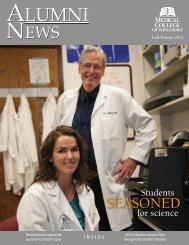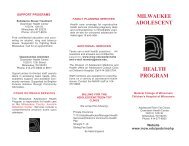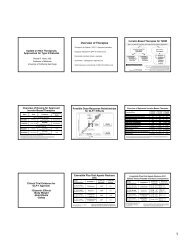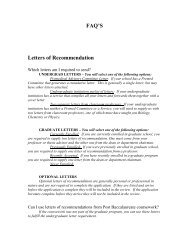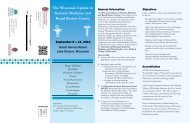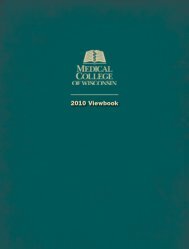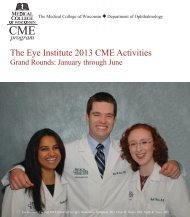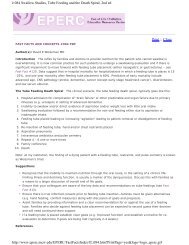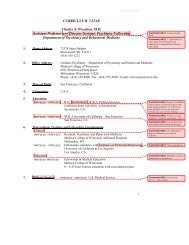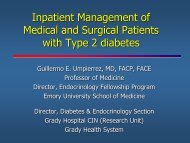Consensus and Controversy in Diabetes and Dyslipidemia
Consensus and Controversy in Diabetes and Dyslipidemia
Consensus and Controversy in Diabetes and Dyslipidemia
You also want an ePaper? Increase the reach of your titles
YUMPU automatically turns print PDFs into web optimized ePapers that Google loves.
<strong>Consensus</strong> <strong>and</strong> <strong>Controversy</strong> <strong>in</strong><strong>Diabetes</strong> <strong>and</strong> <strong>Dyslipidemia</strong>Om G<strong>and</strong>a MDDirector, Lipid cl<strong>in</strong>icJosl<strong>in</strong> <strong>Diabetes</strong> Ctr.Boston, MA
DisclosuresDr. G<strong>and</strong>a does not have any f<strong>in</strong>ancialrelationships relevant to thispresentation to disclose.
CVD Outcomes <strong>in</strong> DM vs non- DM102 Prospective studies; 698, 782 people, 8.5 million person-yr of follow-upThe Emerg<strong>in</strong>g Risk Factors Collaboration, Lancet 2010; 375: 2215-22Multivariate adjusted
Supremacy of Stat<strong>in</strong>s <strong>in</strong>CVD Risk Reduction
HPS: Major Vascular Events by LDLCholesterolRisk ratio <strong>and</strong> 95% CILipid Levelsat EntrySimvastat<strong>in</strong>(10,269)Placebo(10,267)STATINBetterPLACEBOBetterLDL cholesterol (mg/dl)< 100 282 (16.4%) 358 (21.0%) 100 < 130 668 (18.9%) 871 (24.7%) 130 1083 (21.6%) 1356 (26.9%)ALL PATIENTS 2033 (19.8%)2585(25.2%)0.424% SE 3reduction(2P
LDL-C : Less is More3.72.9Relative Riskfor CoronaryHeart Disease(Log Scale)2.21.71.31.0Grundy, S. et al., Circulation 2004;110:227-39.40 70 100 130 160 190LDL-Cholesterol (mg/dL)
CTT: Meta-analysis of 26 Stat<strong>in</strong> Trialsn= 129, 526n= 39612CTT Trialists. Lancet 2010; 376: 167-181CV mortality: - 20 %; Total mortality - 10%
Is there a po<strong>in</strong>t of No-Return?
23 % had diabetes: same outcome
Stat<strong>in</strong>-<strong>in</strong>duced Myalgia / Myopathy:Underly<strong>in</strong>g Mechanism?
AHA, 2008Simvastat<strong>in</strong> <strong>and</strong> Myopathy
Myopathy Associated with 80 mg of Simvastat<strong>in</strong> Daily, Accord<strong>in</strong>g toSLCO1B1 rs4149056 GenotypeSLCO1B1 encodes theorganic anion transport<strong>in</strong>gpolypeptide OATP1B1 thatregulates hepatic uptake ofstat<strong>in</strong>s.
06-08-2011FDA Drug Safety Communication: New restrictions,contra<strong>in</strong>dications, <strong>and</strong> dose limitations for Zocor(simvastat<strong>in</strong>) to reduce the risk of muscle <strong>in</strong>jury
Stat<strong>in</strong>-<strong>in</strong>duced <strong>Diabetes</strong>?
Intensive vs Moderate Dose Stat<strong>in</strong>:New Onset <strong>Diabetes</strong>Preiss, D et al JAMA 2011; 305: 2556-2564
Lipid Changes with Stat<strong>in</strong> alone orStat<strong>in</strong> +EZEPooled analyses, 27 studies, 4-24 wk , n= 15253 (non-DM), <strong>and</strong> 6541 (DM)Leiter, LA et al, Diab, Ob, Metab 2011; on- l<strong>in</strong>eDM vs NDM , p= 0-04 or less, foe each
Potential LDL Lower<strong>in</strong>g Agents• Thyromimetic (Eprotirome)Mean reductions <strong>in</strong> LDL,a po-B, ~ 30%,TG, ~ 40%, <strong>and</strong> LP(a), ~ 40%• Anti-sense apoB synthesis <strong>in</strong>hibitor~ 30% reduction <strong>in</strong> LDL-C <strong>in</strong> patients with FH(Basel<strong>in</strong>e LDL-C: 420 mg/dl)• PCSK-9 Inhibitors
Effects of Eprotirome (KB 2115) on Serum LipidsMean age ~60 yr, BMI 27.5, LDL-C ~ 140 mg/dl on Stat<strong>in</strong> Rx, n= 44-47 eachNo change <strong>in</strong> TSHNo adverse effectson Heart, BonePutative mechanisms: ↑ SRB-1, Chol 7 α–hydroxylase, liver/gut ABCG 5/8 activity, ↓SREBP-1cLadenson PW et al. N Engl J Med 2010;362:906-916
Effect of PCSK9 antibody (REGN 727) onLDL-C with or without Stat<strong>in</strong>s/c <strong>in</strong>jection on Day 1, 29, 43Ste<strong>in</strong>, EA et al NEJM 2012; 366: 1108-118
<strong>Diabetes</strong> Patients Have High Residual CVDRisk After Stat<strong>in</strong> TreatmentEvent Rate(No <strong>Diabetes</strong>)Event Rate(<strong>Diabetes</strong>)On Stat<strong>in</strong> On Placebo On Stat<strong>in</strong> On PlaceboHPS* (CHDpatients)19.8% 25.7% 33.4% 37.8 %CARE † 19.4% 24.6% 28.7% 36.8%LIPID ‡ 11.7% 15.2% 19.2% 22.8%PROSPER § 13.1% 16.0% 23.1% 18.4%ASCOT-LLA ‡ 4.9% 8.7% 9.6% 11.4%TNT ║ 7.8% 9.7% 13.8% 17.9%HPS Collaborative Group. Lancet. 2003;361:2005-2016.Sacks FM, et al. N Engl J Med. 1996;335:1001-1009.LIPID Study Group. N Engl J Med. 1998;339:1349-1357.Shepherd J, et al. Lancet. 2002;360:1623-1630.Sever PS, et al. Lancet. 2003;361:1149-1158.Shepherd J, et al. <strong>Diabetes</strong> Care. 2006;:29:1220-1226.* CHD death, nonfatal MI, stroke, revascularizations†CHD death, nonfatal MI, CABG, PTCA‡CHD death <strong>and</strong> nonfatal MICHD death, nonfatal MI, stroke║CHD death, nonfatal MI, resuscitated cardiac arrest, stroke(80 mg vs 10 mg atorvastat<strong>in</strong>)
ADA/ACC <strong>Consensus</strong> Statement“…In patients with Cardio-metabolic Risk, we recommend guid<strong>in</strong>gtherapy with apo-B measurements, <strong>and</strong> treatment to apo-B goals, <strong>in</strong>addition to LDL-C <strong>and</strong> non-HDL-C assessment.”TREATMENT GOALSHighest-risk patientsInclud<strong>in</strong>g those with1) Known CVD or2) <strong>Diabetes</strong> plus one or more additionalCVD risk factor*High-risk patientsInclud<strong>in</strong>g those with1) No diabetes or known cl<strong>in</strong>ical CVD but2 or more additional major CVD riskfactors or2) <strong>Diabetes</strong> but no other CVD risk factorsLDL-C(mg/dL)Non–HDL-C(mg/dL)ApoB(mg/dL)< 70 < 100 < 80< 100 < 130 < 90*Smok<strong>in</strong>g, HBP, f/h premature CHD Brunzell JD et al. <strong>Diabetes</strong> Care. 2008;31:811-822.
Objective:Josl<strong>in</strong> Apo-B studyTo compare the prevalence of at-goal levels of LDL-C,non-HDL-C, <strong>and</strong> Apo-B <strong>in</strong> a cohort of patients with<strong>Diabetes</strong> <strong>and</strong> TG> 200 mg/ml, accord<strong>in</strong>g to therecommended targets by ADA/ACC <strong>Consensus</strong>Statement
Discordance between LDL-C, non-HDL-C,<strong>and</strong> Apo-Bn Apo-B < 90 mg/dl (%) Apo-B ≥ 90 mg/dl (%) DiscordanceLDL-C
Discordance between LDL-C, non-HDL-C,<strong>and</strong> Apo-BnApo-B < 80 mg/dl(%)Apo-B ≥ 80 mg/dl(%)DiscordanceLDL-C
Effect of Lower<strong>in</strong>g Triglycerides(with Fibrates) <strong>in</strong> Reduc<strong>in</strong>g Residual Risk?
ACCORD- Lipid Resultsn=5518Mean Age; 62 yrMean f/u: 4.7 yrAdherence ~80%No Rhabdomyolysis.CK> 10x: 0.4 vs 0.3%ALT> 3x: 1.9 vs 1.5%The ACCORD Study Group. N Engl J Med 2010;10.1056/NEJMoa1001282
ACCORD Lipid: Primary Outcome,Exp<strong>and</strong>ed Outcome, <strong>and</strong> DeathHR 0.92 (0.79-1.08)HR 0.94 (0.85-1.05)HR 0.91 (0.75-1.10)HR 0.83 (0.66-1.12)The ACCORD Study Group. N Engl J Med 2010;10.1056/NEJMoa1001282
ACCORD Lipid: Primary Outcome <strong>in</strong>Pre-specified SubgroupsThe ACCORD Study Group. N Engl J Med 2010;10.1056/NEJMoa1001282
Circ 2011;123: 2292-2333NHANESTG > 200 mg/dl:~35% Prevalence <strong>in</strong>Adults with <strong>Diabetes</strong>NHANES, 1999-2002Recommendation…Up to 50% reduction <strong>in</strong> TG levels by <strong>in</strong>tensive lifestylemeasures, <strong>in</strong>clud<strong>in</strong>g reduction <strong>in</strong> sucrose <strong>and</strong> fructose.
Effect of Rais<strong>in</strong>g HDL-C <strong>in</strong>Reduc<strong>in</strong>g Residual Risk?
ARIC: CHD Risk with<strong>in</strong> HDL <strong>and</strong> LDL Categoriesn=13,615F/M (%): 57/43Age 45-64 yr14-yr follow-upMuntner,P et alAm J Med Sci 2011;341: 173-180
Does HDL-C matter if LDL-C is < 70mg/dl?
AIM-HIGH: Primary Composite Endpo<strong>in</strong>tBoden, W et al NEJM 2011; Nov 15:on- l<strong>in</strong>e
AIM-HIGH: Primary Endpo<strong>in</strong>tsBoden,W et al NEJM 2011; Nov 15:on- l<strong>in</strong>e
Cholesterol Efflux Capacity <strong>and</strong>Angiographic Coronary Atherosclerosisn= 442 patients with, <strong>and</strong> 351 without, angiographic CADKhera AV et al NEJM 2011; 364: 127-135
Potential HDL Therapies‣ Cholesterol ester transfer prote<strong>in</strong> (CETP)<strong>in</strong>hibitors (Torcetrapib withdrawn); Dalcetrapib,Anacetrapib‣ APO A-1 mimetic agents‣ PPAR g /a - dual agonists(Muraglitazar, Tesaglitazar withdrawn); Aleglitazar‣ MK-0524A: ER Niac<strong>in</strong> + DP-1 receptorantagonist (Laropiprant)- available <strong>in</strong> EU (Tredaptive)



